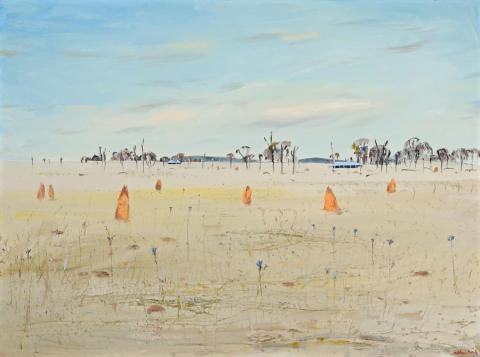WIMMERA LANDSCAPE, c.1970s
ARTHUR BOYD
oil on canvas
90.0 x 120.5 cm
signed lower right: Arthur Boyd
Blue Boy Gallery, Melbourne
Private collection, Melbourne
From his first visit in 1949, Arthur Boyd's evolving vision found an ideal environment in the sparse expanse of the Wimmera region. Boyd painted the flat country capturing the strong, even light, before adding in all he encountered across the sun-bleached fields. Compelled to produce some of his finest landscapes, he would return to the area across the decades. 'The Wimmera was wheat country, and not by any means forbidden, nor forsaken. But in dry hot weather it could have, over sparse, unbroken horizons, a searing expanse of sky that elicited an acute sense of the infinite.'1
Against this boundlessness every detail took on significance to Boyd. In Wimmera Landscape, the foreground is a microcosm of spindly bush-flowers, divots and tracks in the earth, painted with the same detailed attention as the striking anthills, eucalypts and homesteads scattered across the wider plain. Not only is Boyd's affinity with the land reflected in this 'intimacy of the closely seen',2 these paintings herald the Wimmera as 'habitable and inhabited country'.3 The pastoral narratives within each work are enhanced by the aesthetic continuity between them, forming a perceptive, overarching depiction of life and natural cycles in the wheat field district.
When Boyd's Wimmera landscapes were first exhibited in 1950 at the David Jones Gallery, Sydney, both the National Gallery of Victoria and the Art Gallery of New South Wales acquired a painting. These were the first works by the artist to be included in major public collections and firmly established Boyd as 'an interpreter of rural Australian environment'.4 Within the Wimmera and later Shoalhaven series, Boyd's defining vision of specific geographies came to embody the monumental qualities of the land itself.
1. Pearce, B., Arthur Boyd retrospective, Art Gallery of New South Wales, Sydney, 1993, p. 20
2. Philipp, F., Arthur Boyd, Thames and Hudson, London, 1967, p. 60
3. Ibid., p. 62
4. Ibid., p. 67
AMY MARJORAM
